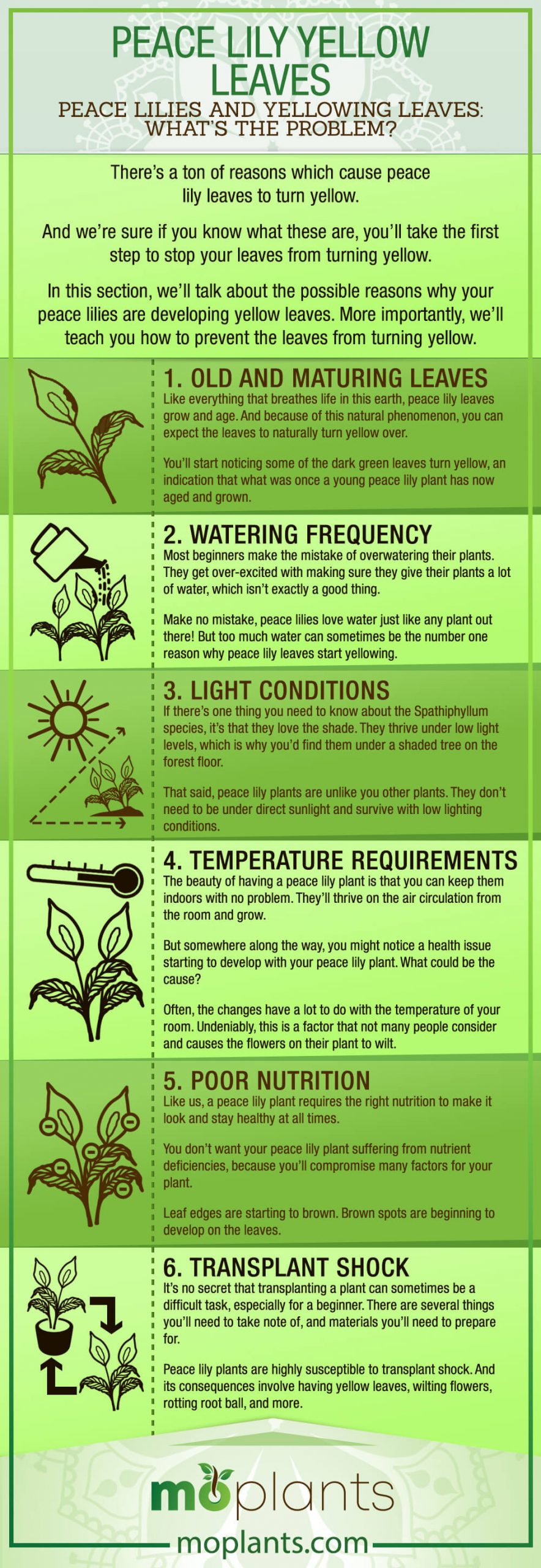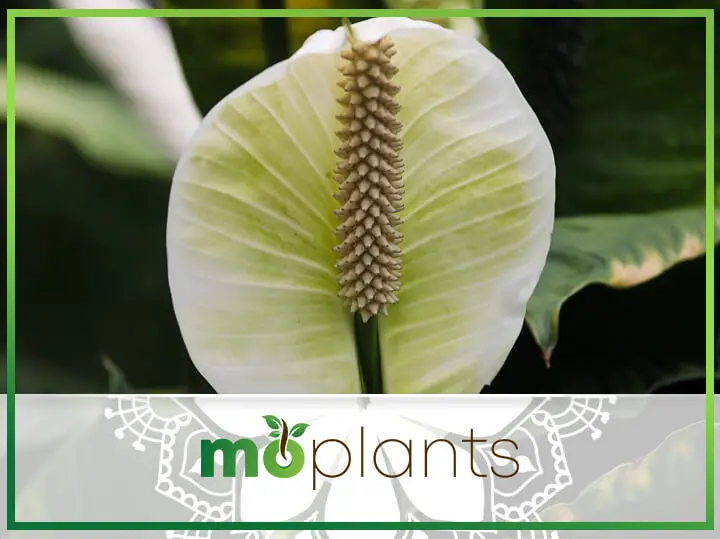A peace lily (Spathiphyllum wallisii) plant is one of the best tropical-looking plants out there. They look gorgeous, with their vibrant dark green leaves and white flower.
Throughout the life cycle of peace lilies, you’ll notice some leaves turning yellow. What could have happened?
Today, we’re here to help you understand why peace lily leaves turn yellow, and how to prevent them.
Ready to turn your yellowing leaves to a vibrant shade of dark green? Let’s go!
Peace Lilies and Yellowing Leaves: What’s the Problem?
There’s a ton of reasons which cause peace lily leaves to turn yellow.
And we’re sure if you know what these are, you’ll take the first step to stop your leaves from turning yellow.
In this section, we’ll talk about the possible reasons why your peace lilies are developing yellow leaves. More importantly, we’ll teach you how to prevent the leaves from turning yellow.
1. Old and Maturing Leaves
Like everything that breathes life in this earth, peace lily leaves grow and age. And because of this natural phenomenon, you can expect the leaves to naturally turn yellow over.
You’ll start noticing some of the dark green leaves turn yellow, an indication that what was once a young peace lily plant has now aged and grown.
But never mistake the yellow leaves as a sign of impending death of your plant.
It doesn’t work that way for plants!
Instead, it merely means that it’s time to take the yellow leaves out and make room for new leaves and flowers.
What Should You Do with Old and Mature Leaves?
Once you notice the leaves on a peace lily turn yellow or dry up, slowly take them out.
Using a shear, make sure to cut the leaves from its stem. Be careful and don’t confuse the stem from that of a healthy one.
From time to time, check on your peace lily and see if the other leaves are turning yellow.
Don’t worry because all this is part of the change. Remember, you’re cutting the yellow leaves to make room for new and healthy green ones.
2. Watering Frequency
Most beginners make the mistake of overwatering their plants. They get over-excited with making sure they give their plants a lot of water, which isn’t exactly a good thing.
Make no mistake, peace lilies love water just like any plant out there! But too much water can sometimes be the number one reason why peace lily leaves start yellowing.
This problem is especially true for people who use a pot or container with little to zero drainage holes. The water is trapped inside, which causes leaves and roots to rot over time. Yikes!
How Can You Prevent Over Watering?
There are different ways to help prevent you from overwatering your lilies, depending on the causes of your concern. We’ll tackle each of the common reasons to help you out.
Be Intuitive
Watering your plants should be intuitive. Think of it like how we know when to drink water, which is when we feel thirsty. Intuitive!
Sometimes, working with a watering schedule isn’t always a good idea for your plants.
As much as possible, it’s better to water your plants when they need it and once you notice that the soil is starting to dry up.
As a rule of thumb, we recommend checking on your peace lilies’ soil moisture once in a while. If it’s starting to crumble and you notice the soil starting to crack and dry up, water it just enough!
Use a Good Potting Soil
There are many soils to choose from, but not all are suited for a houseplant like peace lilies.
We recommend selecting a potting mix that can hold water and moisture and at the same time drain excess water well.
Using a potting mix of this type is ideal for a houseplant, and helps address the problem of overwatering your plants. You want soil that can absorb water for the roots.
Use a Pot With a Drainage Hole
Before buying a pot, check the bottom part and see if there are holes. If there aren’t, you better return that pot on the shelves and look for another.
Always use a pot that has drainage holes underneath. Why? Well, imagine where all the accumulated water will stay after overwatering your plants. They’ll go nowhere!
Water stays inside the pot, causing a ton of problems to your peace lily. Leaving water can rot the roots and cause leaves to yellow and brown. Yikes!
Water Quality
Finally, you’d also want to pay close attention to the water you give your plants.
Peace lilies are highly sensitive to chemicals like chlorine, which can damage their leaves.
There’s no rule which prevents you from using tap water. But, do note that tap water often has high magnesium content which can also be damaging.
3. Light Conditions
If there’s one thing you need to know about the Spathiphyllum species, it’s that they love the shade. They thrive under low light levels, which is why you’d find them under a shaded tree on the forest floor.
That said, peace lily plants are unlike you other plants. They don’t need to be under direct sunlight and survive with low lighting conditions.
Placing your peace lilies under direct sunlight can contribute to the leaves turning yellow, develop brown spots, brown edges, and many more problems.
Luckily, you can quickly remedy this problem by changing the location of your peace lilies.
Where Should You Put Your Peace Lilies
Make no mistake in thinking that peace lilies don’t need light. They still need light, though not as much light like compared to a regular plant.
You can put your peace lilies just about anywhere in your home. However, do note that it must be in a place where light doesn’t hit the most. You can place it on top of a counter and right by the window.
4. Temperature Requirements
The beauty of having a peace lily plant is that you can keep them indoors with no problem. They’ll thrive on the air circulation from the room and grow.
But somewhere along the way, you might notice a health issue starting to develop with your peace lily plant. What could be the cause?
You water your plants, give it enough TLC, but the leaves are starting to change for some other reasons you can think of. Vibrant dark green leaves to yellow in a few days, what’s happening?
Often, the changes have a lot to do with the temperature of your room. Undeniably, this is a factor that not many people consider and causes the flowers on their plant to wilt.
What Room Temperature Should a Peace Lily Be In?
In general, a peace lily plant can thrive in temperatures ranging from 65 to 85 degrees Fahrenheit. It’s the common temperature reading for most homes so that a peace-lily plant can survive indoors.
The issue starts to come up once there’s a change in the weather condition or environment.
For example, putting a peace lily plant out in your cold porch will affect them for the worse! They hate cold drafts, and it causes yellowing on the leaf veins and leaves and other more issues.
That said, make sure to place your peace lily plant in a draft-free area at home, mindful of its temperature requirements.
And once you’ve found this spot, you can say goodbye to yellow leaves, brown leaf tips, and other more problems.
5. Poor Nutrition
Like us, a peace lily plant requires the right nutrition to make it look and stay healthy at all times.
You don’t want your peace lily plant suffering from nutrient deficiencies, because you’ll compromise many factors for your plant.
Leaf edges are starting to brown. Brown spots are beginning to develop on the leaves.
You start noticing many leaves turning yellow. You can face many more problems from lack of proper nutrition, which you can avoid right from the start.
What Kind of Nutrition Should You Give Your Peace Lily Plant?
We highly recommend using organic soil for your peace lily plants. Most organic soils come with a ton of nutrients and minerals meant to promote healthy growth for your plants.
If you notice, the leaves on a peace lily plant that uses organic soil tend to look healthier and vibrant. That’s because the plant is getting enough nutrients it needs to grow.
If you manage to land yourself an excellent soil, we recommend sticking to it. Yellow leaves will be the least of your problems, and you can watch the flower bloom on top of the vibrant green leaves.
6. Transplant Shock
At some point in time, you’ll be wanting to transplant your peace lilies.
For what reason, it’s entirely up to you! You might want to put them in a better pot or separate them so you can grow more peace lilies.
It’s no secret that transplanting a plant can sometimes be a difficult task, especially for a beginner. There are several things you’ll need to take note of, and materials you’ll need to prepare for.
Peace lily plants are highly susceptible to transplant shock. And its consequences involve having yellow leaves, wilting flowers, rotting root ball, and more.
What Are the Tips on How to Safely Transplant Peace Lilies?
It doesn’t take rocket science to transplant peace lilies. If at all, you’ll only need a ton of patience to see the end of the process. We do have several tips for you to live by.
Be careful when trying to remove the plant from the soil. Don’t pull on the leaves to prevent tearing them.
More importantly, don’t pull too hard such that it will break the roots. Remember, the roots give life to the plant.
Put it on the new pot, and plant it firmly on the soil. Water it well, but only enough to keep the soil moist.
Infographic

Conclusion
There you have it, folks. Your search for the right answers is finally over.
We’ve listed the different reasons why your peace lily plant might turn yellow, especially if you’re not careful.
Hopefully, this article can make you more aware of peace lilies, and their issue with yellowing leaves.
If you have any more questions or concerns about this beautiful Spathiphyllum species, let us know in the comment section below. We’d love to answer your questions and help you in every possible way we can.
And if you enjoyed this article, give us a like and share this article with your friends and family. Who knows? They might have a peace lily plant that needs some saving.


